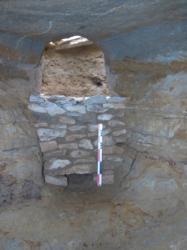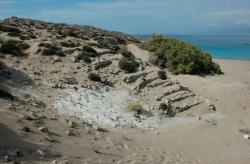INSTITUT SUPERIEUR D'ANTHROPOLOGIE
INSTITUTE OF ANTHROPOLOGY
ONLINE COURSES / COURS A DISTANCE
SUMMER TERM : JULY 2013
REGISTER NOW
FRANCE –
 Marigny Brizay - Un site d’habitat mettant en relation des vestiges de surfaces (silos, trous de poteaux, fossés,…) et des souterrains a fait l’objet d’une fouille préventive à Marigny Brizay (Vienne, chantier COSEA/LGV SEA, juin-septembre 2012). Principalement occupé au Moyen Age, quelques artéfacts archéologiques témoignent d’occupations plus anciennes sur une petite partie du site et aux alentours. Sur une emprise de 22000 m², ce sont sept souterrains déconnectés qui ont été fouillés et étudiés. Cinq d’entre eux sont circonscrits à l’intérieur d’un enclos quasi rectangulaire de 1800 m², sans que ni les galeries, ni les salles ne se trouvent au-delà des fossés limitant l’enclos en surface. Ils sont plutôt destinés au stockage et au refuge. Un ensemble souterrain remarquablement conservé a fait l’objet d’une étude architecturale approfondie ainsi que d’un relevé en trois dimensions, relevé à but patrimonial et scientifique. La fouille des puits, des accès, des axes de circulation et des salles, couplée avec une étude minutieuse des traces d’outils, permet de mieux apprécier les méthodes et les dynamiques de percement de ce genre de vestiges.
Marigny Brizay - Un site d’habitat mettant en relation des vestiges de surfaces (silos, trous de poteaux, fossés,…) et des souterrains a fait l’objet d’une fouille préventive à Marigny Brizay (Vienne, chantier COSEA/LGV SEA, juin-septembre 2012). Principalement occupé au Moyen Age, quelques artéfacts archéologiques témoignent d’occupations plus anciennes sur une petite partie du site et aux alentours. Sur une emprise de 22000 m², ce sont sept souterrains déconnectés qui ont été fouillés et étudiés. Cinq d’entre eux sont circonscrits à l’intérieur d’un enclos quasi rectangulaire de 1800 m², sans que ni les galeries, ni les salles ne se trouvent au-delà des fossés limitant l’enclos en surface. Ils sont plutôt destinés au stockage et au refuge. Un ensemble souterrain remarquablement conservé a fait l’objet d’une étude architecturale approfondie ainsi que d’un relevé en trois dimensions, relevé à but patrimonial et scientifique. La fouille des puits, des accès, des axes de circulation et des salles, couplée avec une étude minutieuse des traces d’outils, permet de mieux apprécier les méthodes et les dynamiques de percement de ce genre de vestiges.
http://www.arkemine.fr/index.php
ROYAUME UNI –  Gelligaer - An archaeological dig is set to begin this summer in Gelligaer. The project at Gelligaer Cemetery will begin after initial investigations to extend the cemetery indicated significant Roman remains of national importance. The dig will uncover what is thought to be the remains of an original Roman road.
Gelligaer - An archaeological dig is set to begin this summer in Gelligaer. The project at Gelligaer Cemetery will begin after initial investigations to extend the cemetery indicated significant Roman remains of national importance. The dig will uncover what is thought to be the remains of an original Roman road.
http://www.caerphillyobserver.co.uk/news/883079/archaeologists-get-go-ahead-to-investigate-romans-at-gelligaer/
USA – Lake Michigan - A wooden beam embedded at the bottom of northern Lake Michigan appears to have been there for centuries, underwater archaeologists announced Tuesday, a crucial finding as crews dig toward what they hope is the carcass of a French ship that disappeared while exploring the Great Lakes in the 17th Century. Expedition leaders still weren't ready to declare they had found a shipwreck or the long-lost Griffin. The ship, commanded by the French explorer La Salle, was never seen again after setting sail in September 1679 from an island near the entrance of Green Bay, in what is now northern Wisconsin, with a crew of a six and a cargo of furs. Michel L'Hour, director of France's Department of Underwater Archaeological Research, said the timber appears to be a bowsprit, which is a spur or pole that extends from a vessel's stem. In another key development Tuesday, they reported that a probing device had detected a hard surface 18 to 20 feet below the lake bed.
Lake Michigan - A wooden beam embedded at the bottom of northern Lake Michigan appears to have been there for centuries, underwater archaeologists announced Tuesday, a crucial finding as crews dig toward what they hope is the carcass of a French ship that disappeared while exploring the Great Lakes in the 17th Century. Expedition leaders still weren't ready to declare they had found a shipwreck or the long-lost Griffin. The ship, commanded by the French explorer La Salle, was never seen again after setting sail in September 1679 from an island near the entrance of Green Bay, in what is now northern Wisconsin, with a crew of a six and a cargo of furs. Michel L'Hour, director of France's Department of Underwater Archaeological Research, said the timber appears to be a bowsprit, which is a spur or pole that extends from a vessel's stem. In another key development Tuesday, they reported that a probing device had detected a hard surface 18 to 20 feet below the lake bed.
http://www.denverpost.com/nationworld/ci_23488979/wooden-beam-lake-michigan-appears-have-been-there
GRECE –  Lefki - Koufonisi is a small island in the Libyan Sea just off the South East coast of Crete and the Cape of Goudouras. It is also named Lefki (“white”), so called because of its white rocks and sand, limestone being the dominant type of rock there. There is a cluster of small islets in the area like Makroulo, Strogylo, Trahila and Marmara. The island is deserted, mostly covered with sand reminding an African landscape. Until 1976 the shepherds used to graze their sheep there but it was not inhabited. Later archaeologist N. Papadakis began excavations on the island, which proved to be full of ancient sites. One of the finds was the ancient theatre of Lefki. The theatre of Lefki was built in the 2nd century AD and has a capacity of 1,000 seats. Its koilon has 12 seating rows and an almost perfect semi-circular shape. The orchestra is slightly bigger than the semicircle. The scene building consists of the proskenion (logeion), the hyposkenion and the paraskenia, and there were two side vaulted entrances into the theater. Today the theatre lies buried in the sand. Now, the “Vitsentzos Kornaros” Progressive Association of Sitia and the Association “Diazoma” have launched a campaign to inform people about the theatre, and encourage them to help rescue and restore the ancient theatre of Lefki.
Lefki - Koufonisi is a small island in the Libyan Sea just off the South East coast of Crete and the Cape of Goudouras. It is also named Lefki (“white”), so called because of its white rocks and sand, limestone being the dominant type of rock there. There is a cluster of small islets in the area like Makroulo, Strogylo, Trahila and Marmara. The island is deserted, mostly covered with sand reminding an African landscape. Until 1976 the shepherds used to graze their sheep there but it was not inhabited. Later archaeologist N. Papadakis began excavations on the island, which proved to be full of ancient sites. One of the finds was the ancient theatre of Lefki. The theatre of Lefki was built in the 2nd century AD and has a capacity of 1,000 seats. Its koilon has 12 seating rows and an almost perfect semi-circular shape. The orchestra is slightly bigger than the semicircle. The scene building consists of the proskenion (logeion), the hyposkenion and the paraskenia, and there were two side vaulted entrances into the theater. Today the theatre lies buried in the sand. Now, the “Vitsentzos Kornaros” Progressive Association of Sitia and the Association “Diazoma” have launched a campaign to inform people about the theatre, and encourage them to help rescue and restore the ancient theatre of Lefki.
http://www.archaiologia.gr/en/blog/2013/06/20/fundraising-for-a-theatre-buried-in-the-sand/